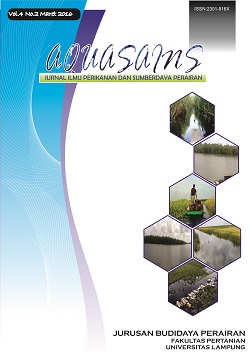Performance of Green Mussel (Perna viridis) in Monoculture and Polyculture System Within Sea Bass (Lates calcarifer )
Abstract
Green mussel (Perna viridis) is oyster has high potential to be developed. A huge market demand is an important factor to optimized green mussel cultivation, there are to system that could be applied for cultivation green mussel is polyculture and monoculture. The purposed of this study is to determined growth performance of green mussel which culture in monoculture and polyculture system. Green mussel is culture in floating cage bath of monoculture and polyculture system. In polyculture system green mussel placed within seabass (Lates calcarifer). Growth performance of green mussel determined by comparizing growth in wide and body lenght using T-test to analyzed factor that assigned to growth performance used principle component analysis (PCA) to environment factor such as Total Amonia Nitrogen (TAN), Total Organic Matters (TOM), Total Suspended Solid (TSS) and phytoplankton both in polycultured and monocultured system. The result of this research was shown that growth in this significant shown from third place where sample collected at 0-100 in depth The results showed that this significant growth was shown from the third place where the samples were collected at 0-100 in depth and the second place where the samples were collected at 100-150 in depth. This is caused by availability of feed source such as TOM and phytoplankton thy driven by sea current. The significant value shown by growth in wide of mussel shell at 100-150 cm in depth.
Downloads
Downloads
Published
How to Cite
Issue
Section
License
License for Authors
Authors who publish with this journal agree to the following terms:
- Authors retain copyright and grant the journal right of first publication with the work simultaneously licensed under a Creative Commons Attribution License that allows others to share the work with an acknowledgement of the work's authorship and initial publication in this journal.
- Authors are able to enter into separate, additional contractual arrangements for the non-exclusive distribution of the journal's published version of the work (e.g., post it to an institutional repository or publish it in a book), with an acknowledgement of its initial publication in this journal.
- When the article is accepted for publication, its copyright is transferred to Aquasains Journal. The copyright transfer convers the exclusive right to reproduce and distribute the article, including offprint, translation, photographic reproduction, microfilm, electronic material, (offline or online) or any other reproduction of similar nature.
- Authors are permitted and encouraged to post their work online (e.g., in institutional repositories or on their website) prior to and during the submission process, as it can lead to productive exchanges, as well as earlier and greater citation of published work (See The Effect of Open Access).
- The Author warrant that this article is original and that the author has full power to publish. The author sign for and accepts responsibility for releasing this material on behalf os any and all-author. If the article based on or part os student’s thesis, the student needs to sign as his/her agreement that his/her works is going published.
License for Regular Users
Other regular users who want to cite, distribute, remix, tweak, and build upon author’s works, even for commercial purposes, should acknowledge the work’s authorship and initial publication in this journal, licensed under a Creative Commons Attribution License.
This license lets others distribute, remix, tweak, and build upon your work, even commercially, as long as they credit you for the original creation.
This work is licensed under a Creative Commons Attribution 4.0 International License.Copyright Transfer Statement can be downloaded here


.png)









